Royalist Counterstamps
La Comandancia Militar (L.C.M.), 1811 – 1814
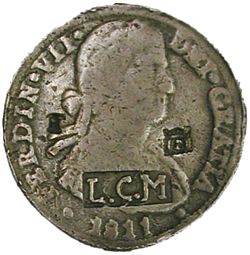 The best known and most commonly encountered of the Royalist counterstamps is that of La Comandancia Militar (L.C.M.), used in Northern Mexico (Chihuahua and Monclova). These counterstamps were used from 1811 to 1814: The LCM counterstamp is quite rare on 1814 hosts, strongly indicating the counterstamp was discontinued early in that year. In fact, the few Royalist counterstamps of 1814 are all rare and Insurgent stamps are nonexistent.
The best known and most commonly encountered of the Royalist counterstamps is that of La Comandancia Militar (L.C.M.), used in Northern Mexico (Chihuahua and Monclova). These counterstamps were used from 1811 to 1814: The LCM counterstamp is quite rare on 1814 hosts, strongly indicating the counterstamp was discontinued early in that year. In fact, the few Royalist counterstamps of 1814 are all rare and Insurgent stamps are nonexistent.
PradeauA. F. Pradeau, Numismatic History of Mexico from the Pre-Columbian epoch to 1823. New York, 1938 believed that these initials stood for La Comandancia Militar but there is no documentary evidence to support that and there have been other suggestions. There has even been some debate as to whether this was a Royalist or Insurgent counterstamp. My studies indicate that 85% of the host coins are from Chihuahua or Monclova and this counterstamp was used thru early-1814. These northern cities were outside of Insurgent control from late 1811 on, and so I believe that Pradeau was right that this was a Royalist stamp of the northern military command. There are at least 17 different LCM dies, which suggests that these were used in many locations in northern Mexico. Given the high percentage of post-1813 struck Chihuahua 8 reales that shows traces of the LCM counterstamp, its use must have been extensive before the recall of the cast Chihuahua and Monclova coinage.
Antonio Linares, Valladolid, 1811 – 1814
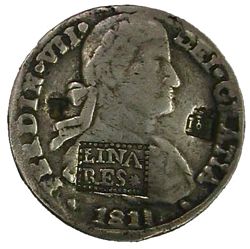
Pradeau assigns the LINARES counterstamp to the Insurgents under Don (José) María Chico de Linares, Hidalgo’s paymaster general in the early days of the War for Independence. Pradeau stated that the counterstamp was first used by Insurgent forces in November, 1810 in Guadalajara. This is a mistaken assignment which carries to this day in Krause as Insurgent KM#261. Rather than an Insurgent issue this counterstamp should be assigned to the Royalists under Lieutenant-Colonel Antonio Linares in Valladolid.
The LINARES counterstamp is rare and underrated. The majority of the hosts know to me are from Zacatecas and are dated 1812-1813 (with single outliers dated 1811 and 1814). The assignment to José María Chico de Linares is not valid for a couple of reason. First, I would expect any countermark from this paymaster to carry his father’s surname “Chico” rather than Linares and more importantly, Chico de Linares was captured with Hidalgo at Bajan and executed on 27 June 1811. The unfortunate Chico de Linares was not around to counterstamp these pieces in 1812-1814. As for alternatives to Antonio Linares, there were no significant Insurgent leaders (or towns) named Linares during this period. Even if there were, Antonio Linares fits perfectly! The timing and host coins correspond with the LCM issues and certainly point to the Valladolid-Zacatecas area. A Royalist assignment however, raises the question of why a Royalist commander would not use the LCM stamp so prevalent further north during this period? I believe it is due to Valladolid’s unique isolation for much of the war between 1811 and 1814. Pradeau recognized this error in a 1962 Numismatist articleA. F. Pradeau, "El resello "Linares"" in Numismatist, but the mistake has not been corrected in current day catalogs.
Antonio Linares was an important Royalist commander who served with distinction throughout the War for Independence. He began the War for Independence as a Captain under Calleja in late 1810. By May of 1811 Linares commanded the troops in Valladolid under Trujillo. Valladolid was in the vortex of Insurgent activity from 1810-1813. The Insurgents under Junta leaders Rayón, Liceaga, and Verduzco, and sub-commanders Muñiz and Albino García were encamped around Valladolid for much of the war and kept it under constant attack. On at least three separate occasions they nearly took her. In fact, Valladolid was the only major city under such duress after early 1812, often cut off from communication with other Royalist commands for much of the period until early 1814. Linares figures prominently in frustrating many Insurgent campaigns and dreams. In February 1812, then Colonel Linares repelled a major attack on Valladolid by Muñiz, Albino García and Father Navarrette, pursuing Muñiz as far as his Tacámbaro headquarters where he burned the town and destroyed Muñiz’s foundry. On 30 January 1813 the now Lieutenant-Colonel Linares routed 15,000 Insurgents attacking Valladolid under the combined leadership of Verduzco and Muñiz. This single engagement that I refer to as “THE BIG EVENT” is probably responsible for more Insurgent counterstamps and mint casting stamps than any other. We’ll explore this when we examine the Insurgent issues in the next Journal. Linares went on to defeat Minas near Guanajuato in October 1817 and finished the war as Comandante-General of Celaya which fell to Iturbide in May 1821. The ever loyal Linares refused to submit to the revolution when Celaya fell. Out of respect for his long and brave service, Iturbide granted Antonio Linares safe passage to Mexico City.
Las Cajas de Veracruz, Dec. 1812 – early 1813
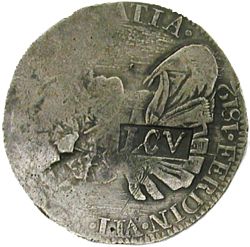
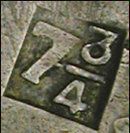
Zs 1812 8 reales with LCV counterstamp Stamp indicating value of 7¾ reales
By late 1812 there was a large amount of provisional money, especially of Zacatecas, flowing thru the port city of Veracruz. A decree of 19 December 1812 ordered that all the provisional coins circulating in Veracruz should be weighed and stamped as to the value at which they should be accepted. These carry the monogram “LCV” on one side and an indication of weight on the other. Four dies were made to stamp the short-weight coins, one for seven reales, another for seven and a quarter, another for seven and a half, and a fourth for seven and three quarters. However, since most provisional Zacatecas issues were of proper weight, few counterstamped coins indicated a weight as few were found to be short.
This is probably the most counterfeited counterstamp in the entire War for Independence series and should be approached with caution. The real counterstamps are quite rare. As an example the plate coin for KM#198 is not genuine. A starting place for the evaluation of this issue is to ensure that the coin weighs true to its indicated value. When reviewing past auctions, I’ve found another reliable method of separating the false counterstamps from those that are valid. Where the price realized is below $1,000 you have found a fake!
Armijo, mid January 1814
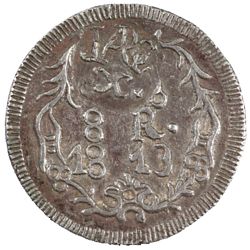
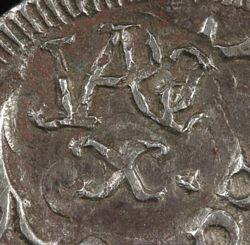
SUD 1813 8 reales with Armijo counterstamp
This is one of the few counterstamps that occur after 1813. General José Armijo chased the Insurgents from Chilpancingo in January 1814 and captured their papers, their baggage and their silver, including a large number of 1813 Morelos SUD 8 reales. Armijo had these stamped with his monogram and crossed palms. I presume this counterstamp was to “mark” the King’s booty and prevent theft. Armijo brought this silver back to Mexico City, where it was almost certainly melted. Luckily a few of the counterstamps survive.
Valladolid, 1814 or 1815
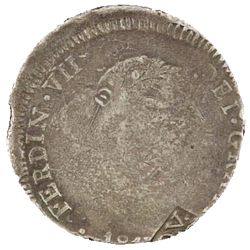
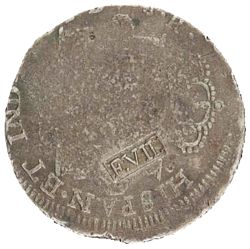
Valladolid 1813 8 reales with P.D.V. and F.VII counterstamps
This is another of the rare Royalist counterstamps applied after 1813 and, like the Armijo issue, it served a somewhat unique purpose.
In 1813 Valladolid, in the heart of Insurgent activity and under constant attack since 1811, asked for permission to mint its own coins. The Royalist authority in Mexico City gave permission but did not dictate the design of the coins. Valladolid first produced the ‘shield” design which was recalled after the Mexico City authorities objected to an issue that did not adhere to standardized draped bust design. A draped bust issue was then prepared which was very poorly executed and is quite rare.
By 1814 the mint workshop was closed. Shortly after its closure, a neighbor reported seeing the cleaning lady and a companion entering the workshop at night. The authorities investigated and found that she had been admitting a local jeweler, who was utilizing the dies to strike debased Valladolid coinage. The jeweler was jailed. The Valladolid coinage was recalled and the unauthorized issues with their debased silver were destroyed. Two counterstamps were applied to those found to be of proper fineness. The two counterstamps: were “P.D.V.” on one side indicating Provisional de Valladolid in a rectangle and “F.VII” (Ferdinando VII) on the other. These stamps are only known on extremely rare Valladolid hosts as should be expected.
